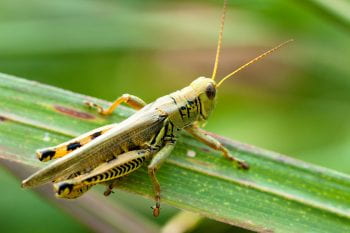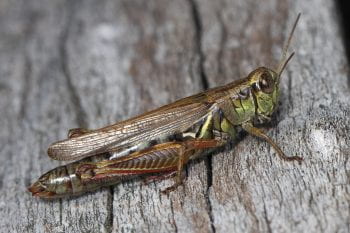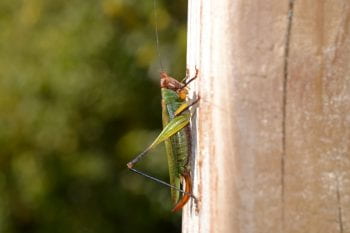What is an orthopteran?

The diferential grasshopper. Photo by Melissa McMasters, via Wikimedia Commons (CC BY 2.0)
An orthopteran is a member of the taxonomic order of insects Orthoptera, which includes grasshoppers, crickets, katydids, and locusts. Orthopterans are characterized by their muscled hind legs and two pairs of wings. The name Orthoptera, meaning “straight wing,” comes from their long, narrow forewings, also known as tegmina. Fossil evidence of orthopterans appear as early as 250 million years ago (Himmelman 45). Today, the order contains over a thousand known species in North America alone and over 23,000 worldwide (Milne 415).
Classification of Orthoptera
The order Orthoptera is split into two suborders, Ensifera—katydids and crickets—and Caelifera—grasshoppers. Several noticeable features can be used to differentiate between members of the two suborders. For example, caeliferans have shorter antennae, whereas ensiferans’ antennae are typically longer than their bodies. The location of their hearing organs, or tympana, also distinguish the two orders—a grasshopper’s tympana are located on its abdomen, whereas a katydid’s tympana are located on its tibiae (Himmelman 55). These suborders get their names from the shape of the female’s ovipositor. Caelifera means “chisel-shaped” and Ensifera translates as “sword-bearing” (Himmelman 45).
Anatomy

Head: The frontal region of the insect.
- Antennae: Sensory appendages used to help the insect collect information about its surroundings (Himmelman 47).
- Palpi: Appendages along the sides of the mandibles used in the consumption of food (Himmelman 47).
Thorax: The midsection of the insect.
- Tegmina: An orthopteran’s long, narrow outer forewings (Milne 415).
- Femur: The upper part of the leg connected to the thorax (Himmelman 48).
- Pronotum: A protective plate that wraps around the thorax (Himmelman 48).
- Tibia: The lower part of the leg, often spiked (Himmelman 48)
- Tarsus: Foot-like structure composed of three to four segments varying between species (Himmelman 48).
- Tympana: Hearing organs. Located on the abdomen of caeliferans and on the tibiae of ensiferans (Himmelman 55).
Abdomen: The abdomen, the largest body part of most insects, is home to the orthopteran’s sexual and digestive organs (Himmelman 48).
- Aedeagus: The male orthopteran’s sexual organ (Himmelman 49).
- Cerci: Appendages located at the tip of the abdomen. Some species’ cerci are prominent, but most have small and short cerci (Milne 415).
- Ovipostior: The female orthopteran’s sexual organ, used for laying eggs. In caeliferans, the ovipositor is short, whereas in ensiferans, the ovipositor has a long, tapered, pointed structure (Himmelman 45).
Insect Songs
Male orthoptera, including most grasshoppers, crickets, and katydids, produce distinctive songs during certain parts of the year. The insects typically generate these sounds by rubbing together rough parts of their wings and legs (Milne 415). Scientists often use differences in these unique songs to distinguish between species and to identify new ones (Roach). An area rich with insect calls can also indicate the health of the ecosystem (Himmelman 34).
The insects employ several methods to create sound (Himmelman 54). Stridulation is the rubbing of the femur with the edge of the tegmen. Crepitation, only made during flight, is the rapid opening and closing of the hind wings.
These songs are primarily used as a mating call, intended to attract a mate, and is vital for courtship (Milne 415). The songs’ seasonal patterns indicate when a new generation’s males become reproductively viable (Walker).
Thomas J. Walker, an entomologist at University of Florida, is developing Singing Insects of North America (SINA), a website intended to catalog the singing insects of North America and their songs. Though currently incomplete, SINA serves as a good resource for learning about these insects and listening to their distinctive songs. Visit the website here.
Common Orthoptera Species of Missouri
Clicking on a species’ common name will direct you to its SINA entry, where you can listen to the insect’s song and find more information about the species.
Short-horned grasshoppers (Family Acrididae)
Differential grasshopper (Melanoplus differentialis):

Photo by Melissa McMasters, via Wikimedia Commons (CC BY 2.0)
The differential grasshopper is a relatively large short-horned grasshopper. When desperate for food, swarms can cause devastating damage to Missouri crops (“Differential Grasshopper”). This grasshopper is typically brownish-yellow, but color can vary widly, from green to olive to brown. Its hind legs are yellow with black spikes running along them. They typically range from 1.125 to 1.75 inches in length (Milne 421). The differential grasshopper typically resides in grasslands and large open fields all throughout Missouri (“Differential Grasshopper”). Differential grasshoppers eat a large assortment of foliage, including agricultural crops (“Differential Grasshopper”).
Red-legged locust (Melanoplus femurrubrum):

Photo by Judy Ghallager, via Flickr (CC BY 2.0)
The red-legged locust, also known as the red-legged grasshopper, is listed by the US Department of Agriculture as a crop pest and can cause serious damage to crop fields. The red-legged locust often contains poultry tapeworms, which mature in the game birds that eat the insect (“Red-legged grasshopper”). As its name suggests, this dark brown grasshopper’s hind legs are a bright red and adorned with black spikes (Milne 422). The red-legged locust resides in open fields and vacant lots throughout Missouri (“Red-legged grasshopper”). The species consumes a large variety of plant materials, including Southwestern crops (“Red-legged Grasshopper”).
Katydids (Family Tettigoniidae)
Black-legged meadow katydid (Orchelimum nigripes):

Photo courtesy of Andrew Cannizzaro, via Flickr (CC BY 2.0)
Growing up to 1.5″, this katydid has a rich green body, red eyes, and black legs. The species is usually found in open meadows and eats grasses. Occasionally, they can become pests in small gardens (“Black-legged Meadow Katydid”).
Common true katydid (Pterophylla camellifolia):

Photo by James St. John, via Flickr (CC BY 2.0)
With its uncanny leaf-like appearance, the true katydid’s natural camouflage keeps it safe and sound in the leafy treetops in which it resides. Appearing all throughout the state of Missouri, katydids can be heard at night singing their signature song: “Katy did, Katy didn’t” (“Common True Katydid”). This katydid species can grow up to 2.5 inches (“Common True Katydid”). True katydids typically make their homes in treetops in woodlands and other forested areas Making use of their habitat, these katydids rely on the leaves of the deciduous trees they live in for food (“Common True Katydid”).
True crickets (Family Gryllidae)
House cricket (Acheta domestica):

Photo by Brian Gratwicke, via Flickr (CC BY 2.0)
The house cricket is an extremely abundant orthopteran species. Round and a brownish color, these crickets typically grow to be anywhere between ⅝ and ⅞ inches. Its hind wings extend beyond its abdomen and cerci when at rest. Found nearly worldwide, the house cricket is a common nuisance as it makes its home primarily indoors in residences and buildings, where they subsist on crumbs and food discarded by humans (MIlne 439).
Field cricket (Gryllus pennsylvanicus):
The field cricket ranges between ⅝ and 1 inch. Typically a black or dark brown color, the field cricket has long antennae, and its wings do not extend past its cerci. Seen throughout North America, the field cricket usually feeds on plant materials and fruits, but will eat other dead insects on occasion.
Works cited
“Black-legged Meadow Katydid.” MDC Discover Nature. Missouri Department of Conservation, n.d. Web. 15 Dec. 2016.
“Common True Katydid.” MDC Discover Nature. Missouri Department of Conservation, n.d. Web. 15 Dec. 2016.
“Differential Grasshopper.” MDC Discover Nature. Missouri Department of Conservation, n.d. Web. 14 Dec. 2016.
Himmelman, John. Cricket Radio. Cambridge, Mass: Harvard UP, 2011. eBook Academic Collection (EBSCOhost). Web. 16 Dec. 2016.
Milne, Lorus, and Margery Milne. National Audubon Society Field Guide to North American Insects and Spiders. New York: Knopf, 1980. Print.
Pfadt, Robert E. “Field Guide to Common Western Grasshoppers.” Grasshoppers of Wyoming and the West. University of Wyoming, n.d. Web. 16 Dec. 2016.
“Red-legged Grasshopper.” MDC Discover Nature. Missouri Department of Conservation, n.d. Web. 15 Dec. 2016.
Roach, John. “Cricket, Katydid Songs Are Best Clues to Species’ Identities.”National Geographic. National Geographic Society, 5 Sept. 2006. Web. 16 Dec. 2016.
Walker, Thomas J. “Seasonal Patterns.” Singing Insects of North America. University of Florida, n.d. Web. 12 Dec. 2016.